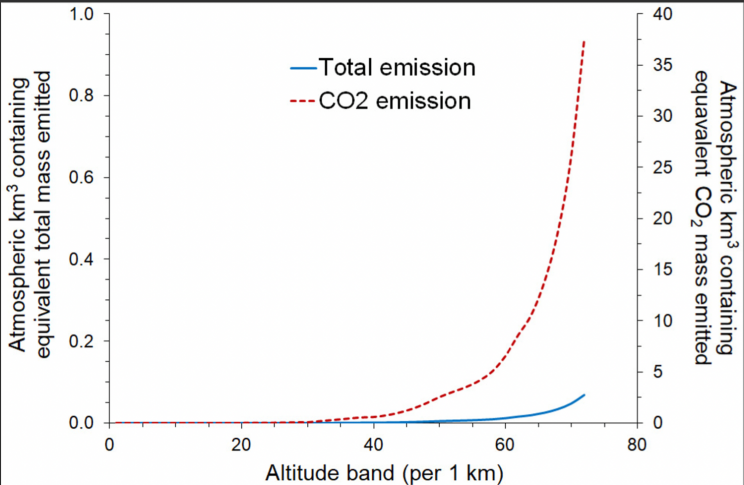With the price of launching a rocket into area falling, the variety of rocket launches is, nicely, taking off. Final 12 months, governments and firms internationally efficiently launched 133 rockets into orbit, breaking a file that stood for 45 years.
However there is a catch. Breaking free from Earth’s gravity requires a rocket to launch an incredible quantity of vitality in a brief time frame. As a rocket leaves Earth, it produces sizzling exhaust that modifications the physics and chemistry of the environment because it passes by way of. In a paper printed Tuesday within the peer-reviewed journal Physics of Fluids, a pair of physicists simulated the launch of a SpaceX Falcon 9 rocket blasting into area.
They discovered a number of causes to be involved.
The carbon footprint is not the issue
Rockets aren’t answerable for placing that a lot carbon dioxide into the environment. A typical launch burns roughly the identical quantity of gasoline as a day-long industrial flight however produces seven instances as a lot CO2 — between 200 and 300 tons — because the airliner. That is way more carbon than the typical particular person will generate of their lifetime, but it surely’s a rounding error in comparison with the 900 million tons of CO2 the aviation trade was spewing yearly earlier than the pandemic.
However that is not the entire story. “We do not care a few rocket’s carbon footprint. That is irrelevant,” says researcher Martin Ross. For him, it is the particles contained in rocket exhaust — mainly alumina and black carbon — that actually matter. “These particles scatter and soak up daylight. They alter the temperature and circulation of the stratosphere,” Ross says.
Sadly, scientists solely have a faint understanding of the entire environmental impression of a rocket launch. “The present stage of information about rocket emissions doesn’t present researchers with sufficient info to totally assess the impression of launches on the worldwide setting,” Ross says.
The impact of carbon emissions excessive within the environment is unsure
The researchers behind the brand new examine are bringing the issue into sharper focus by modeling the exhaust from the 9 nozzles of a Falcon 9 rocket because it launches into area. These simulations incorporate information in regards to the rocket and its propellant (RP-1) with equations that describe how gases behave beneath varied situations. Because of some severe computing energy, the researchers had been capable of predict how exhaust behaves after exiting the nozzles, at increments of roughly 0.6 miles (1 km) in altitude.
The researchers analyzed the launch by evaluating the quantity of exhaust launched throughout one kilometer of upward journey by way of a sure band of the environment (e.g. between 2 km and a pair of.99 km) with the properties of the environment at that particular altitude. They needed to undertake this considerably complicated methodology as a result of the bodily and chemical make-up of the environment is completely different at completely different altitudes.
They discovered that the quantity of whole exhaust is “negligible” in comparison with the air round it, even at excessive altitudes. That is a shock as a result of the environment is far much less dense at increased altitudes. Based on their calculations, the quantity of exhaust launched by a Falcon 9 because it travels between 70 km and 70.99 km (roughly 43 miles) is simply one-fourteenth the quantity of mass present in one cubic kilometer (roughly .25 mi3) of air at that altitude. (That is conveyed by the blue line within the chart under.)

What is not negligible is the quantity of CO2 {that a} Falcon 9 introduces into increased ranges of the environment because it passes by way of (represented by the dotted crimson line within the determine above). As soon as it passes an altitude of 27 miles (43.5 km), a rocket begins emitting a couple of cubic kilometer’s value of CO2 for every kilometer it climbs. By the point it reaches 43.5 miles (70 km), a Falcon 9 releases greater than 25 instances the quantity of CO2 present in a cubic kilometer of air at that altitude.
And rocket exhaust accommodates greater than carbon
It is greater than CO2. “Maybe much more crucially, the [amount of] carbon monoxide (CO) and water (H2O) [in rocket exhaust] are of the same order as carbon dioxide,” the authors write. That is a priority as a result of there’s hardly any carbon monoxide or water excessive within the environment. “Subsequently, these compounds’ emissions at excessive altitudes introduce an much more important contribution/rise to the present, if any, hint quantities already current.”
Water vapor instantly freezes at that altitude, however researchers do not know the place these ice crystals find yourself. Carbon monoxide reacts with hydroxide (O2) to type much more CO2. The researchers additionally found that harmful exhaust emissions known as thermal nitrogen oxides (NOx) can stick round for a very long time in sizzling rivers earlier than dispersing all through the environment, particularly at decrease altitudes.
The long run is unsure, however researchers and regulators are paying consideration
With simply greater than 100 launches per 12 months, some say that air pollution from rockets is not a problem. “One of many arguments that folks have used previously was to say that we do not really want to concentrate to rockets or to the area trade, or the area trade is small, and it is all the time going to be small,” Ross says.
He would not agree. “I believe the developments that we’re seeing the previous few years present that … area is getting into this very speedy development section like aviation noticed within the ’20s and ’30s.”
The authors behind the brand new examine really feel the identical means. “We consider that the issue of atmospheric air pollution brought on by rocket launches is significant and must be addressed appropriately as industrial area flights, specifically, are anticipated to extend sooner or later,” they write.
The issue of air pollution from rockets slowly coming into clearer focus, and it is being taken significantly in excessive locations. Later this 12 months, the World Meteorological Group and the UN Environmental Program will launch new a report that summarizes how rocket emissions deplete ozone. Optimistically, this consideration will trigger atmospheric air pollution to change into a key issue within the design of future rockets.

